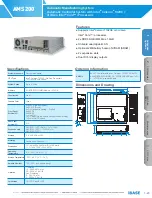
BAC Document Number: Easybond MKII Manual V03
28/08/13
Page
17
of
32
7.6 TESTING A COMPLETED BOND
Threaded pin attachments should be tested by a torque device. For an M8 pin the torque device
should be set to 10 Nm. The threads will fail at 25 Nm so do not use excessive force.
Direct braze pin attachments must be tested as per
STEP FIVE – figure 8
as follows:
The shank of the plain pin must be carefully broken off with a hammer taking care not to
damage the lug. This must be done before another pin braze is made to the bond. After
breaking off the shank the broken surface should be level or thereabouts with the outer surface
of the lug
(figure 9 [A]).
The lug shall be complete in all aspects.
STEP FIVE
Figure 8
If the surface of the broken pin is proud of the surface of the lug this is an indication that the
brazing time was too short
*
(figure 9 [B]).
The reason for a short braze time is usually the result
of excessive current being drawn due to the gun "lift height" being incorrect. This short time can
also be caused by a poor earth connection.
If the surface of the broken pin is below the surface of the lug, this is an indication that the
brazing time was too long
(figure 9 [C]).
The reason for a long braze time is the result of
insufficient current being drawn. Insufficient current is usually the result of a poor battery
condition.
If it is known that the battery is good then the cause may be incorrect setting of the gun "lift
height".
If the ferrule is not held against the copper lug and is in partial contact then the arc can escape
out of the gap and this will result in the side of the copper lug burning away.
Warning: Repeated bond attempts must not be made at the same position as this may
cause structural/metallurgical damage to the base steel.
* When using cable lugs part number #278 100 9000 /#278 100 7360 this result (
figure 9
[B])
is acceptable due to thickness of copper material at braze area. Height of remaining
brass shank should not exceed 2mm.
















































